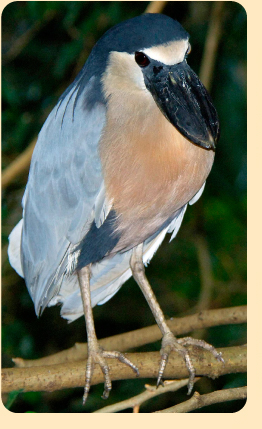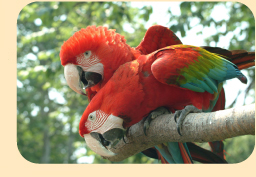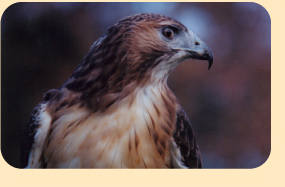Middle School
 In this activity, students will learn to recognize different types of animal behavior and use graphing skills to determine patterns in behaviors.
Method In this activity, students will learn to recognize different types of animal behavior and use graphing skills to determine patterns in behaviors.
Method
Students will observe a bird of their choice at the National Aviary for 10 minutes. They will watch the bird and record their findings every 30 seconds on an animal observation chart. They will make a bar graph and interpret their results.
Materials
Animal observation charts, graph paper, pencils, stopwatch or clock, clipboards.
Background
Most animals exhibit behaviors that fall into one of five or six categories. By generalizing the behaviors they have observed, students can begin to form hypotheses about how animals spend their time. Animals with high metabolisms, like birds, may spend many hours a day in the wild foraging just to maintain their energy level. In zoos, however, they do not need to “hunt” for their food, and may spend more time socializing with each other or displaying other behaviors. By charting their results and comparing them with each other, students can hypothesize how and why animals spend their time the way that they do.
Procedure
1. Introduce students to the different broad categories of animal behavior.
a. Sitting/Resting – Animals conserve their energy by resting for periods throughout the day. Many birds will rest by tucking one of their legs up into their body. It may appear awkward to us, but it helps to rest that leg as well as conserve body heat. If a bird is sleeping, many of them will tuck their heads into the feathers of their back, in between the wings. Tell your students to look for these behaviors as they observe their birds.
b. Foraging – Foraging behavior can include feeding from the food pans located in each exhibit, drinking water, scratching through the dirt in search of insects, and filtering tiny organisms out of the water as the flamingos do. Foraging behavior, for the purpose of this activity, is any behavior where the bird can be seen “hunting” for food or consuming food or water.
 c. Preening – Birds spend a remarkable amount of time preening, or fixing their feathers, throughout the day. They will go over each individual feather using their beak to smooth and realign them. If a feather is in poor condition, it may no longer be waterproof, allow the bird to fly, or provide insulation – so it is important to keep feathers in prime condition.
d. Courtship – Some of the birds at the Aviary display remarkable courtship behaviors. They are sometimes difficult to observe, but may include two birds feeding each other, gathering nesting materials, elaborate songs or calls, or fancy feather displays like those from our male Argus pheasant (where he will spread his wings and tail and “dance” for the female.) This is generally only displayed between birds of the same species.
e. Aggression – This is another behavior that may more difficult to observe. Aggression includes any behavior from the birds that could be considered a “fight” – usually a dispute over territory or food. Aggressive behavior may include chasing each other, “facing off” and calling to each other, and driving another bird away from a food source. This may be displayed between members of the same species, or members of different species.
2. Go over the animal observation chart with students. Explain that they will be recording what they observe their bird doing every 30 seconds for 10 minutes. Some of the challenge in this activity is deciding what type of behavior your bird is displaying! You’ll be surprised how well you can get to know a bird in only 10 minutes of observation. If you see a behavior that does not seem to fit in any of the above categories, try to write down some observation notes and discuss the behavior with the class.
 3.Once the students have observed their bird for 10 minutes, ask them to discuss any “weird” behaviors they observed. If the behavior can’t be sorted into one of the five categories, the observation can be excluded from the graphing activity.
4. Ask the students to make a bar graph of their observations by charting the number of times they observed a bird displaying a type of behavior. For older students, you can also have them calculate the fraction or percentage of time the bird spent on each activity.
5. Have the students discuss and present their findings. Depending on the students’ age, ask students to theorize why their birds acted the way that they did. Did they spend most of their time foraging because food was just placed in the room? Did they show aggression because they have a nest nearby? Did they preen themselves because they just took a bath? Possibilities are endless and there are no wrong answers!
Extensions
For grades 1-2:
 Observe animals using a simpler picture chart (circle pictures of activities rather than writing). Observe animals using a simpler picture chart (circle pictures of activities rather than writing).
 Have the class observe the same type of animal and make a chart of results for the whole class using a bar graph. Have the class observe the same type of animal and make a chart of results for the whole class using a bar graph.
 Develop concepts of what activities the animals spend the most time doing and ask students why that may be so. Develop concepts of what activities the animals spend the most time doing and ask students why that may be so.
 Emphasize observation skills, graphing skills, and basic data interpretation Emphasize observation skills, graphing skills, and basic data interpretation
For grades 3-4:
 Allow students to make “field observations” and their own notes about animal behavior. Allow students to make “field observations” and their own notes about animal behavior.
 Students can choose their own bird to observe and chart individually. Students can choose their own bird to observe and chart individually.
 Students can interpret their own results and present them to the class. Students can interpret their own results and present them to the class.
 Hypothesize why the bird was behaving the way that it was. Hypothesize why the bird was behaving the way that it was.
 Use fractions or percentages to interpret results. Use fractions or percentages to interpret results.
 Emphasize observation skills, graphing skills, presentation/public speaking skills, data interpretation. Emphasize observation skills, graphing skills, presentation/public speaking skills, data interpretation.
For grades 5-6:
 Observe the same bird for 2 or 3 sessions throughout the day. Observe the same bird for 2 or 3 sessions throughout the day.
 Compare sessions and discuss any differences between them. (Ex: my bird appears more active during the morning because it is hungry and foraging for food.) Compare sessions and discuss any differences between them. (Ex: my bird appears more active during the morning because it is hungry and foraging for food.)
 If possible, form a hypothesis after the first session but before the second session and try to predict the bird’s behavior based on the amount of time it spent on each activity. Alternatively, have students hypothesize how they think their bird will act if something in their environment changes. (Ex: If another bird comes too close to my bird, I think that my bird will show aggression). If possible, form a hypothesis after the first session but before the second session and try to predict the bird’s behavior based on the amount of time it spent on each activity. Alternatively, have students hypothesize how they think their bird will act if something in their environment changes. (Ex: If another bird comes too close to my bird, I think that my bird will show aggression).
 Present results along with a brief report on their bird’s natural history. Present results along with a brief report on their bird’s natural history.
 Emphasize observation skills, graphing, interpretation of scientific data, scientific method, research skills, and public speaking/presentation skills. Emphasize observation skills, graphing, interpretation of scientific data, scientific method, research skills, and public speaking/presentation skills.
|

